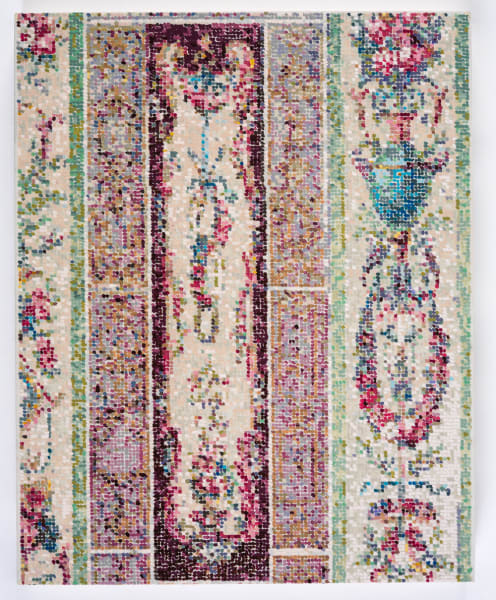After French Decoration One
Kirstin Lamb
After French Decoration One, 2018
Gouache and acrylic on duralar on board
20 x 16 x 1.5 inches
Ruane Center for the Humanities, Second Floor
About the Work
Kirsten Lamb began her ‘embroidery paintings’ as a way to incorporate her interests in women’s work and textile design into her painting process. Many of the embroidery paintings are influenced by French wallpaper of the early modern period. “The re-presenting of this particular decorative moment is, for me, an echoing of the darker uses of antiquity as a stand-in for beauty and power,” says Lamb about the inspiration for this body of work. In order to paint the images not already patterned on a stitch grid, the artist digitally generates a dot-matrix and paints each gridded stitch by hand onto clear acetate, a plastic-like substrate. Like the wallpapers they’re based on, Lamb’s embroidery paintings experiment with color and composition in ways that elucidate, complicate, and update the meanings of ancient symbolism.
Each work in Kirsten Lamb’s After French Wallpaper series appropriates imagery specific to the Louis XVI style of Neoclassicism: a movement in architecture, design and the arts across Europe that was especially dominant in France from approximately 1760 to 1830. The French Neoclassical movement was focused on extremely detailed reproductions of Classical forms, all quietly imbued with strong political and social messages. It was a style fit for kings, emperors, and revolutionaries alike. Subtitled After French Decoration One, Two, Three and Four, the works on view here trace the particularities of French Neoclassical decoration, representing both the court and the body politic of French society.
After French Decoration One juxtaposes tapestry and damask patterns from the first and second half of the eighteenth century, showcasing the dramatic change in decoration after the unearthing of Pompei and Herculaneum during the middle of the same century. This combination of patterns, meant to show a progression of time, was distinctive for its emphasis on archaeological exactitude, the result of French Neoclassicist artists’ unprecedented level of knowledge of the art and architecture of the ancient world.
